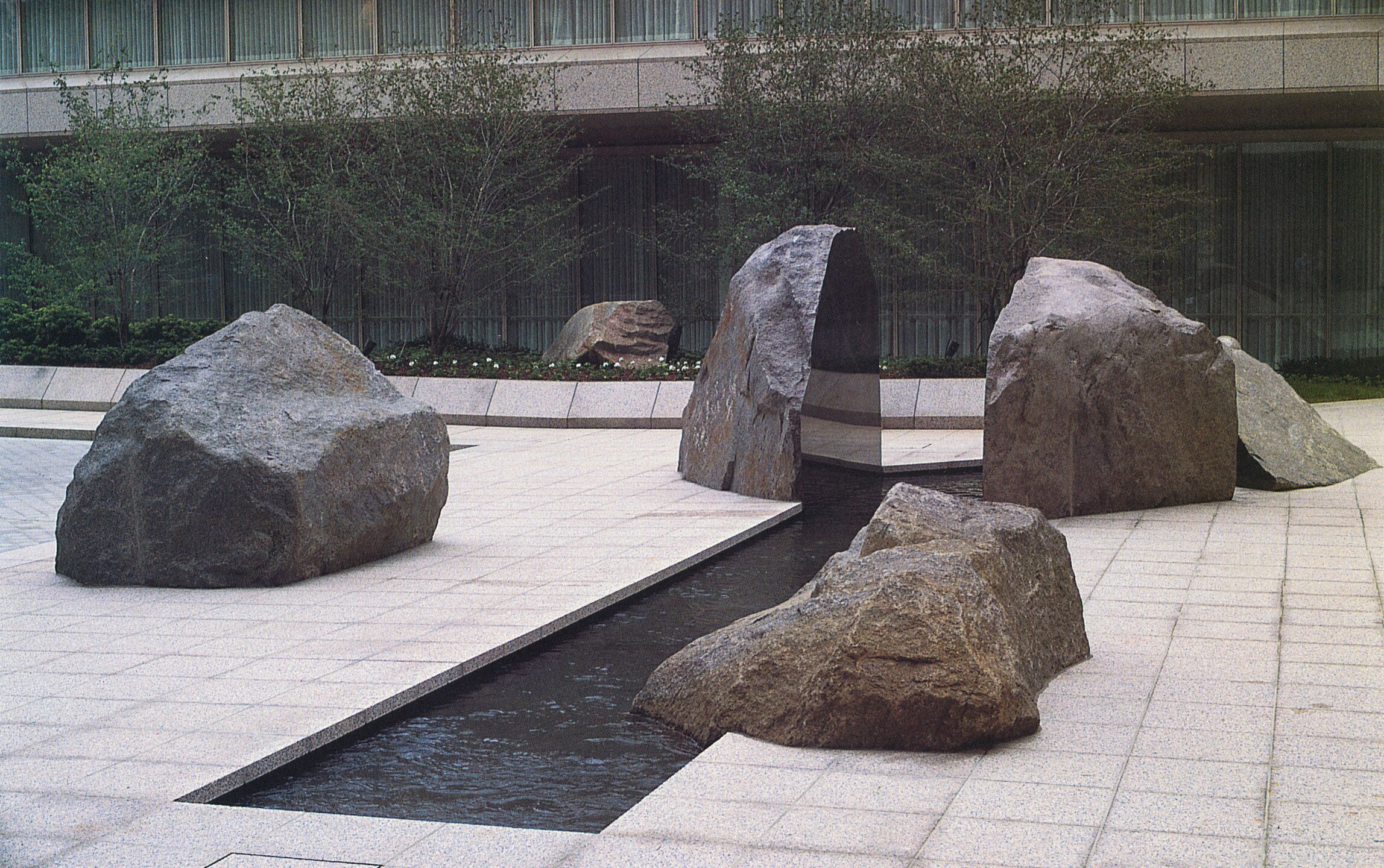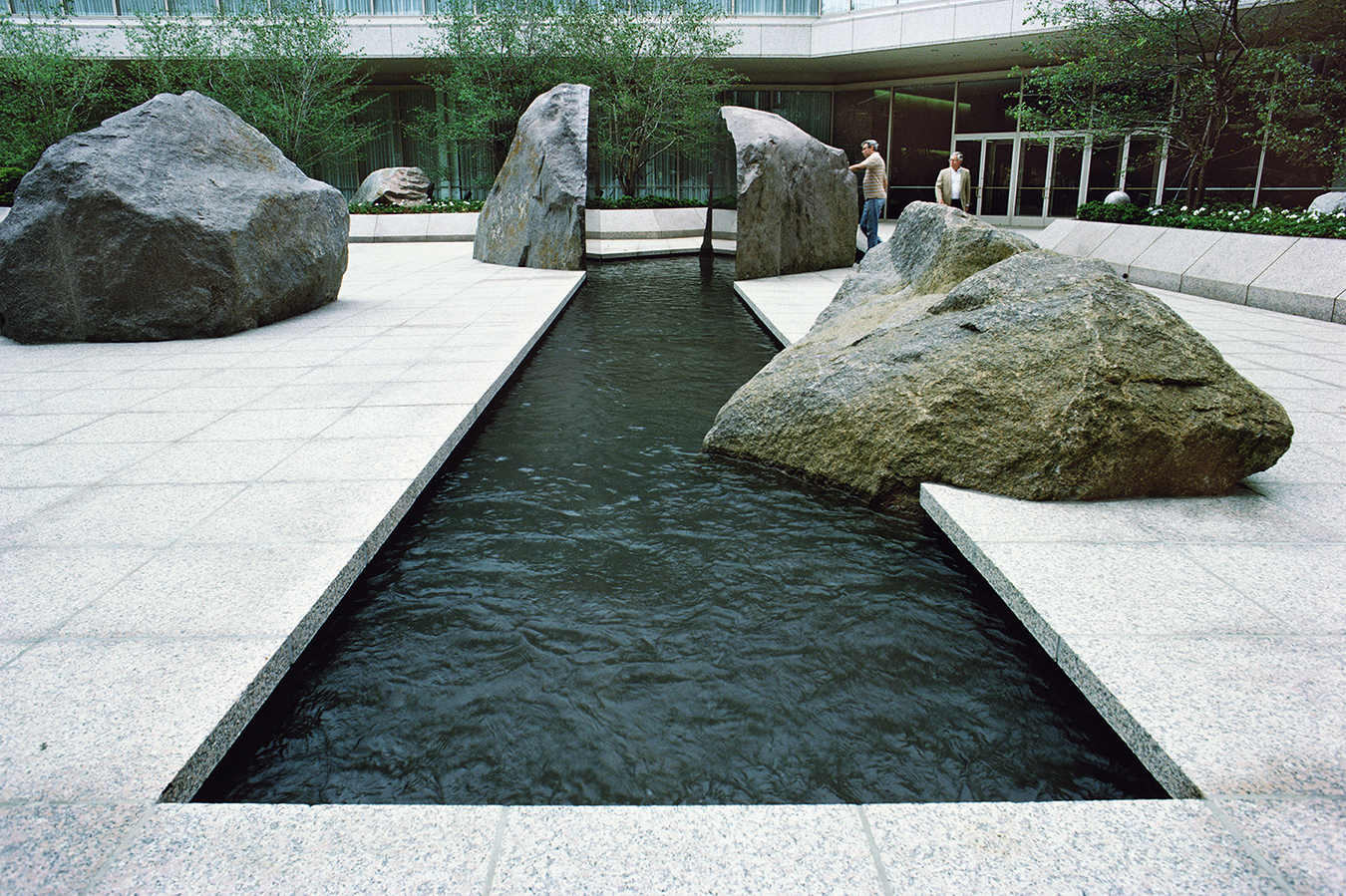Elyn Zimmerman’s monumental work, Marabar, finds a new home at AU.
Marabar, a million-pound split-rock sculpture by American artist Elyn Zimmerman, has commanded attention at the National Geographic Society’s (NGS) headquarters in Washington, D.C., since 1984. On the NGS campus at 17th and M Streets NW, MARABAR is a long and narrow reflecting pool flanked by five massive mahogany boulders that anchor a sweeping modernist plaza designed by David Childs SOM in collaboration with landscape architect James Urban.

Also Read: LeBron James Innovation Center Blending Modernism With Sport
Because the work is exceptionally site-specific, its erasure as part of a planned renovation led by Washington, D.C.-based Hickock Cole sparked outrage. As a result, it was quickly added to The Cultural Landscape Foundation’s (TCLF) Landslide index of endangered cultural landscapes in March 2020.
After nearly two years, dozens of letters of support, and one game-changing resolution, it has been announced that MARABAR will be relocated approximately four miles to American University’s campus and reinstalled in a new configuration opposite the Katzen Arts Center. The New York Times’ Rebecca J. Ritzel broke the storey earlier this week about a new agreement between American University and the National Geographic Society, with the latter footing the bill for the process.

Also Read: A new shopping centre in Shanghai by Thomas Heatherwick
“It’s a piece of landscape architecture history,” the American University Museum’s director, Jack Rasmussen, told the Times. In the 1970s and 1980s, who was this female sculptor? It is a game-changer. “
According to the March 2021 resolution adopted in response to a TCLF-led campaign urging the Historic Preservation Review Board (HPRB) to reconsider its unanimous August 2019 vote allowing NGS to proceed with its MARABAR-free renovation plans, Zimmerman’s work would be spared removal and relocation within the revamped plaza and instead reinstalled at a then-yet-to-be-determined new location at the expense of the NGS.
According to the resolution, Zimmerman would be actively involved in selecting a “cultural institution or other suitable location” for MARABAR.
Also Read: Fascinating Events On The Stunning Pune Farmhouse Of Natasha Poonawalla
Before the resolution, the NGS proposed relocating MARABAR to Washington Canal Park in southeast D.C. Both Zimmerman and landscape architect Dave Rubin, who designed Washington Canal Park while working as an equity partner at OLIN, were opposed to the plan.

“NGS has assured me that I will play a significant role in overseeing the removal, transportation, and eventual installation of MARABAR components at National Geographic’s expense,” Zimmerman said in a statement issued shortly after the resolution was formalised in March. “I am grateful to the Cultural Landscape Foundation for drawing the HPRB’s attention to Marbar’s impending demolition last year.”
While the TCLF was critical in raising awareness about Marbar’s threatened status, Charles Birnbaum, president and CEO of the Washington, D.C.-based advocacy and education nonprofit, told AN that it took a chorus of diverse and prominent voices to get the job done and save the sculpture from an uncertain fate without Zimmerman’s input.
“There was a powerful, persuasive, and effective convergence of influential voices from numerous disciplines assembled by TCLF in the campaign to save MARABAR—museum directors, curators, artists, landscape architects, historians, and architects, among others, including a Nobel laureate scientist,” he said in an email statement.
As previously reported, the New Yorker’s Adam Gopnik, architect Frederick Fisher, artist and designer Mary Miss, architect and critic Marc Treib, and Childs himself submitted letters of opposition to the HPRB.
In his letter, Childs urged the board to “preserve her [Zimmerman’s] sculpture as part of any modifications contemplated.”

Those letters, of course, were part of a campaign nearly 40 years ago to leave Marbar alone and preserve it in its original location, as Zimmerman had intended. But, unfortunately, this did not work out.
“I’m relieved it’ll stay in Washington,” Zimmerman told the Times, adding that the slim, rectangular water feature at MARABAR will be reconfigured into a crescent shape for its new home at American University. She also revealed that once MARABAR begins its second chapter at its new location (which, as the Times points out, will be more publicly visible near bustling Ward Circle), it will no longer be known as MARABAR.
“It’ll be interesting,” she said.
The massive sculptural installation at NGS headquarters was excavated earlier this month. The installation work at American University is set to begin next summer.
Written By Tannu Sharma | Subscribe To Our Telegram Channel To Get Latest Updates And Don’t Forget To Follow Our Social Media Handles Facebook | Instagram | LinkedIn | Twitter. To Get the Latest Updates From Arco Unico
